墨西哥人脱贫,要靠这种植物
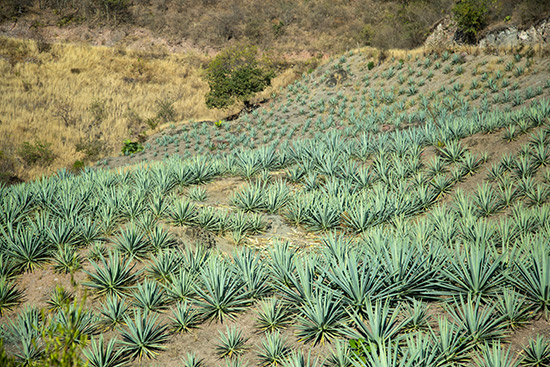
|
从博尼法西奥·克鲁兹·鲁伊斯脸上平静的笑容可以看出,他很为自己种植的龙舌兰感到骄傲。 在鲁伊斯家后院一个手工搭建的小温室里,架子上的烤盘里栽有成千上万的龙舌兰幼苗。每个烤盘上都有几百棵幼苗,有一天它们会长成重达几百磅的巨型植物。博尼法西奥小心翼翼地端着盘子,就像抱着他的孩子一样,从某种角度而言,它们确实是他的孩子。 后院的小苗圃是鲁伊斯参与非营利组织“国际小母牛组织”(Heifer International)墨西哥瓦哈卡试点项目的成果,这是小母牛组织的第一个龙舌兰项目。该组织经常向欠发达地区的人们提供鸡和山羊等家禽家畜。该组织来到鲁伊斯的小镇,帮助那里的村民搭建龙舌兰温室,向他们展示如何照料这些植物。最近,鲁伊斯又更进一步,将自己收到的礼物传递了出去——他也开始和附近的村民分享他种的秧苗,告诉他们如何照料,让他们也能够这样照着种。 |
You can tell by the quiet smile on his face that Bonifacio Cruz Ruiz is proud of his agave plants. Inside a small handmade greenhouse in his backyard, Ruiz has thousands of plants growing on shelves lined with baking sheets. Each sheet contains hundreds of small seedlings that will one day grow into massive plants weighing hundreds of pounds. Bonifacio carries the trays with care, as if they hold his children, and in a way, they do. The backyard nursery is the result of Ruiz’s work with nonprofit Heifer International, through its pilot program in Oaxaca, Mexico, Heifer’s first involving mezcal. The organization, which typically shares livestock such as chickens and goats with people in underdeveloped areas, came to Ruiz’s town and helped him and other residents build greenhouses for agave plants, showing them how to maintain those plants. Recently Ruiz was able to take things a step further and pass the gift along by sharing some of his beautiful seedlings, as well as directions on how to care for them, with neighboring villagers so they could do the same. |
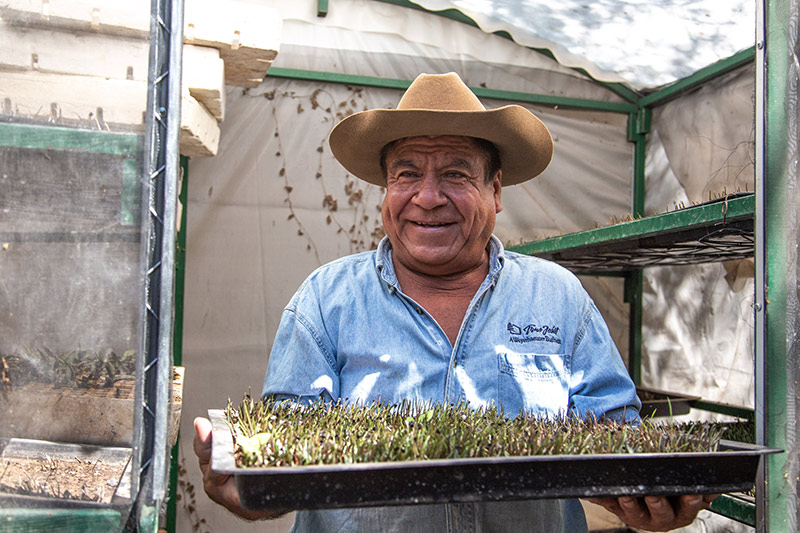
|
鲁伊斯小心翼翼地把托盘放回原处,带着我和小母牛组织的一小部分员工,沿着他家后面大约半英里远的一条有点危险的小路走下去。我们沿着山路上上下下,穿过一条小河,来到一个小花园,他把从烤盘上露头的幼苗移栽到花园里。你可以从他的表情上看出,他为自己的成就和未来的可能性感到骄傲。 |
After he delicately puts the tray back in its resting place, Ruiz leads me and a small group of Heifer employees down a slightly treacherous path roughly a half a mile behind his home. The journey takes us up and down hills and across a small river to a small garden, where he transplants the seedlings once they’ve outgrown their baking-tray beginnings. You can tell by looking at his face that he’s proud of what he’s accomplished and what the future might hold. |
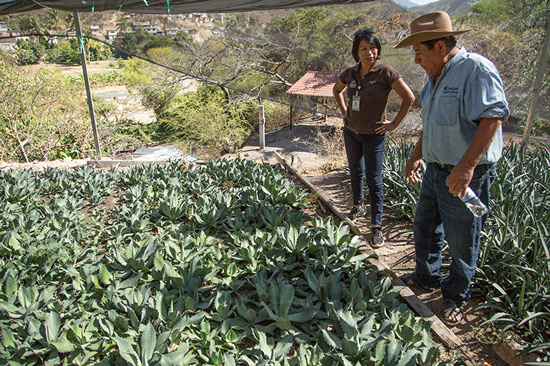
|
在圣安娜德尔里奥镇,有一句谚语:“噩运降临时,喝杯梅斯卡尔酒吧。好事发生时,也喝杯梅斯卡尔酒吧。”这句话的最佳搭配是手捧一杯当地酿造的梅斯卡尔酒,这种饮料在当地适用于一切场合,从下午茶饮品到民间治疗偏方,什么都可以。 多年以来,梅斯卡尔酒一直是当地人们生活中不可缺少的一部分。然而,在这个与世隔绝的小镇上,人们的家里连自来水和电等基本设施都很少有,更别提让梅斯卡尔酒取得商业成功了。他们也难以继续保持当地的传统,因为越来越多的年轻人离开这个地方,去寻找更好的工作机会。许多人最终选择移民到美国。 以前村里用来制作梅斯卡尔的龙舌兰是野生的。然而,当这些野生植物出现问题时,当地村民不得不从其他村庄购买,他们本就十分微薄的利润就变得少之又少。而且野生龙舌兰很难找,采集够做一批梅斯卡尔酒的龙舌兰需要花费很长的时间。 现在,多亏了小母牛组织,鲁伊斯种的龙舌兰不仅能够确保当地可以拥有稳定的龙舌兰供应,而且人们不必再花力气四处寻找野生龙舌兰。 2017年,鲁伊斯和村里的其他成员投票决定,把他们的梅斯卡尔卖给小母牛组织的合作伙伴保乐力加集团(Pernod Ricard),在此之前,保乐力加的代表曾经专程来村里考察。当时的计划是最终要把村里的梅斯卡尔整合到公司颇受欢迎的Del Maguey品牌里。这还没有最终实现,但保乐力加一直在收购储备梅斯卡尔,计划在未来发布新品。 即使官方还没有正式发布,这种合作关系已经取得了一些巨大成果。这个镇子过去曾经以每升8比索(约合50美分)的价格出售梅斯卡尔,现在它的售价已经接近130比索(约合7.5美元),这是一个巨大的进步。村民们的销量也更高。在小母牛组织和保乐力加参与之前,罗德里格斯一家每年一般卖出400升。现在这个数字已经接近1000升。 小母牛组织希望能够助力这种增长,让这门营生在这个家庭年收入平均在3000到5000美元之间的地区中更加持续。现在,当地已经能够生产一种统一的产品,而且意识到了这种酒的市场价值。 除了教鲁伊斯等人如何搭建温室,如何培育幼苗,该组织还帮助当地农民学习技能,例如怎么防止植物不受虫害破坏(龙舌兰往往需要5至7年才能成熟),如何照顾牲畜、防止牲畜染病(它们常用来在陡峭的山坡上驮载这些沉甸甸的植物)。 |
In the town of Santa Ana del Rio, there’s a saying: “Para todo mal, mezcal. Y para todo bien, tambien.” Translation: “For everything bad, mezcal. And for everything good, too.” It’s a saying best accompanied with a glass of the local spirit in your hand and commemorates a liquid that is used in the area for everything from an afternoon drink to a folk remedy to cure illnesses. Mezcal has been an integral part of the local community for generations. However, families in the isolated town—which has exceptionally limited access to basic utilities like running water and electricity—have had trouble making the spirit a commercial success. They’ve also run into trouble keeping the tradition going, as younger members of the community tend to leave the area, seeking greater job opportunities. Many ultimately choose to immigrate to the United States. The agave used to make mezcal in the village has traditionally been harvested from wild plants. However, when something happened to those plants, the village was forced to buy them from other villages, cutting into their already meager profits. Wild agave can also be hard to find, making the process of collecting enough for a batch of mezcal a rather time-consuming task. Now, thanks to Heifer, that agave Ruiz is growing will ensure the area has not only a steady supply of the plant, but also that they’ll be able to locate them quickly. In 2017, Ruiz along with other members of the village voted to sell their mezcal to Pernod Ricard, which is working with Heifer on the program, after a representative from the brand visited the area. The plan at the time was to ultimately integrate mezcal from the village into the company’s popular Del Maguey brand. That hasn’t happened just yet, but Pernod is consistently purchasing the mezcal and storing it with plans to release it in future. Even without the official release, that partnership has fueled some tremendous results. Whereas the town once sold its mezcal for just eight pesos a liter (approximately 50¢), it’s now approaching 130 pesos per liter ($7.50), a significant improvement. The villagers are also selling more. Prior to Heifer and Pernod’s involvement, the Rodriguez family typically sold around 400 liters of mezcal per year. Now that number is closer to 1,000 liters. Heifer wants to help facilitate that growth, making the industry more sustainable for a community where the average annual family income is between $3,000 and $5,000. Now the community is making a consistent product and is aware of the spirit’s market value. Beyond teaching Ruiz and others how to build greenhouses and nurture seedlings, the group also helps local farmers learn skills such as how to prevent pests from destroying the plants, which can often take five to seven years to reach maturity, and how to care for and prevent diseases in their livestock, which are often used to harvest those heavy plants on the steep hills where they grow. |
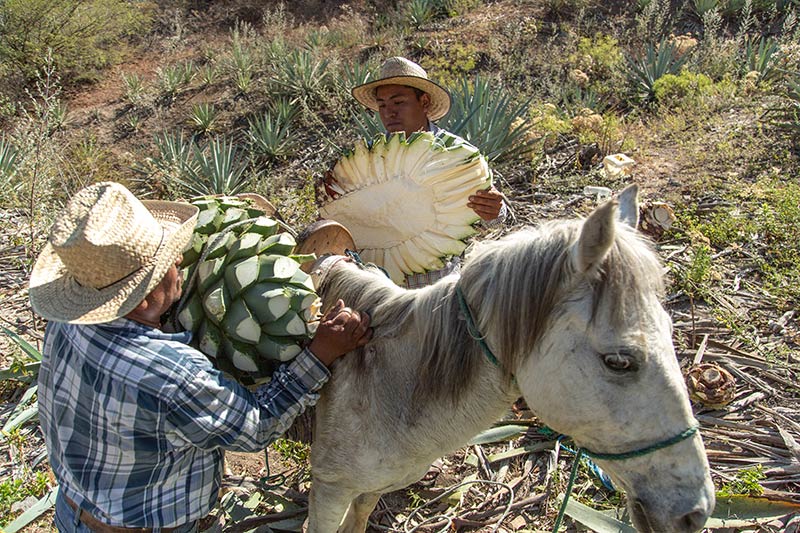
|
西罗·罗德里格斯是村里负责收割龙舌兰的人之一。每一天,他和两个儿子都顶着烈日劳作,收割龙舌兰,这种植物通常重几百磅,他们用大砍刀切掉坚硬的龙舌兰叶,再把龙舌兰中间的芯(piña)运回家里的户外蒸馏室(称为palenque),把龙舌兰酿成梅斯卡尔。 这项工作非常热也非常累,哪怕是对于一个没有动一下手指也没有背任何重物的旁观者来说都是如此。这种植物通常生长在陡峭难以通行的山坡上,它们被绑在驴背上,沿着尘土飞扬的山丘上上下下。 “小母牛组织为我们的马、骡子和驴子提供了疫苗。”罗德里格斯说,“这对我们帮助很大。” 收割龙舌兰需要人工进行,而且一次只能够采摘一棵,最后才可以把龙舌兰的芯装上卡车,运回镇上。 |
Ciro Rodriguez is one of the people responsible for harvesting agave in the village. Each day he, along with his two sons, labors in the sweltering sun, harvesting the agave plants, which can often weigh hundreds of pounds, and then cutting off their tough leaves with machetes before carrying the heart of the plant—the piña—back to their family’s outdoor distillery, called a palenque, to be turned into mezcal. It’s exceptionally hot, laborious work, even for an onlooker who isn’t actually wielding any tools or bearing any heavy loads. Plants often grow on steep, hard-to-navigate inclines, and they’re carried up or down these dusty hills, strapped to the back of the family’s donkeys. “Heifer has provided us with vaccines for horses, mules, and donkeys,” Rodriguez says. “That has helped us a lot.” Once the agave is harvested, a process that’s done by hand one plant at a time, the piñas are eventually loaded into the family’s truck and then driven back into town. |

|
在镇上,这些植物被放置在一个填满热石头的大土坑里。上面铺上泥,烘烤大约一个星期。之后,人们把这些龙舌兰芯进行人工压榨,纤维会放在小蒸馏器中,最后被蒸馏成梅斯卡尔。 |
In town, the plants are placed in a large dirt pit filled with hot stones. Dirt is put on top, and the plants are cooked for roughly a week. Afterward, those piñas are manually pressed, and the fibers are placed in small stills where they’re distilled into mezcal. |

|
这是一个漫长的过程。所有流程都需要在超过100华氏度的室外高温环境下完成,使得原本就很辛苦的工作变得更加困难。它的制作方式也和村子里世代相传的做法非常相似。 目前,梅斯卡尔只散装销售,销售的产品符合保乐力加设定的质量标准。罗德里格斯说:“如果我们想把梅斯卡尔进行灌装,那就意味着要把很多钱付给当局来获得许可。”墨西哥的酒类销售税很高,有时高达60%,因此很难依法销售。 |
It’s a long process. And all these tasks are also performed outdoors in temperatures topping 100 degrees, making an already laborious process even more so. It’s also done in very much the same way it always has been from generation to generation in the village. For now, that mezcal is only sold in bulk, and what is sold is made in a way that it meets quality standards Pernod has set in place. “If we wanted to bottle the mezcal that would mean a lot of money to pay to the authorities and to get permission,” Rodriguez says. Liquor sales in Mexico have high taxes, sometimes near 60%, which can make it hard to market the product in accordance with the law. |
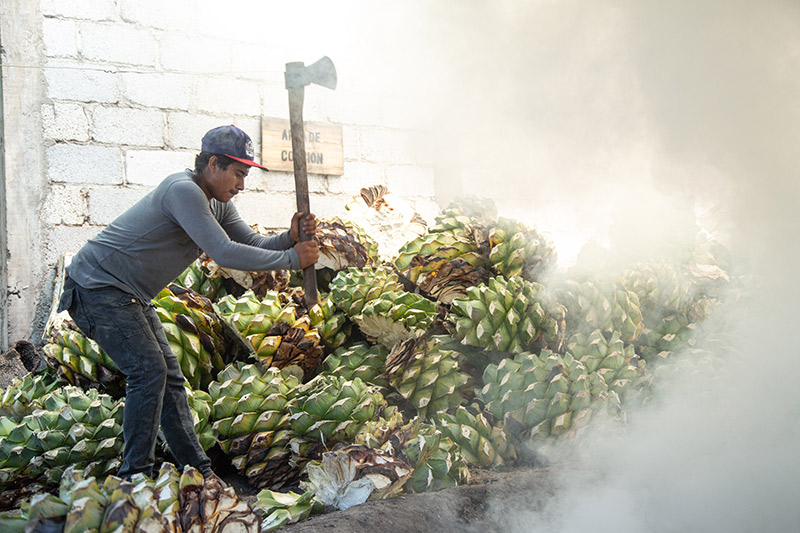
|
现在,这个村子和它的梅斯卡尔生产可以为当地居民提供能够糊口的收入,人们希望可以有更多的人选择留在这里,继续传承这些传统——同时也希望把这门生意进一步发扬光大。 “继续前进。这就是我们现在需要做的。”罗德里格斯说,“我们希望梅斯卡尔的生产能够繁荣发展。我们过去种植龙舌兰和制作梅斯卡尔只是为了种而种,没有得到任何改善或进步。现在我们想拥有自己的品牌。”(财富中文网) 译者:Agatha |
Now that the village, and its mezcal production, can provide a living wage for its residents, the hope is that more of them will choose to stay in the area and keep those traditions going well into the future—and potentially grow the business further. “Continue getting ahead. That is what we’re looking for right now,” Rodriguez says. “We would like the mezcal production to thrive. We used to plant agave and make mezcal just because, without seeing any improvement or progress. Now what we want is to have a brand of our own.” |













